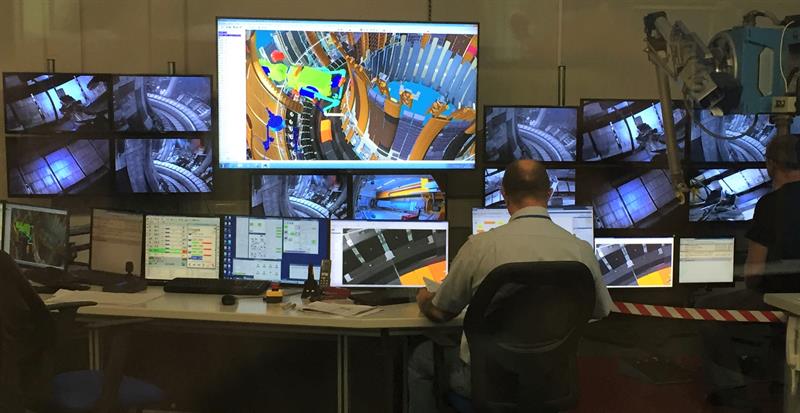As the world’s largest nuclear fusion power experiment, the JET (Joint European Torus) nuclear fusion tokamak is designed to harness energy with the intention of furthering the development of fusion power generation. Fusion is based on the same principle that powers stars like our sun and is seen as a key stepping stone towards a carbon free world in energy production.
Operated by the UK Atomic Energy Authority (UKAEA) at Culham Science Centre near Oxford for a consortium of European fusion scientists, the project started in 1983 and is at the absolute cutting edge of scientific development.
Third Dimension supports quality control and MRO (maintenance, repair and overhaul) of JET with its advanced profile measurement systems. When it began working with UKAEA ten years ago, a handheld GapGun measurement device was used for inspection in and out of the fusion rig. Now, the GapGun has been upgraded to integrate with Third’s Vectro inspection system – which in turn has been attached to the Mascot robotic system developed by the UKAEA’s Remote Applications in Challenging Environments (RACE) department – to improve the speed and productivity of the maintenance procedures.
During operation, the reactor runs for 30 seconds every half hour, with scientists from around the world awaiting the data and test results.
The tokamak has a heating capacity of around 40 MW. In order to achieve power generation through nuclear fusion, plasma temperatures of over 100 million degrees Celsius are required – the hottest temperature in the solar system.
Inside the reactor specially designed 1cm² tiles are densely packed to cover the inner area of the tokamak core, slightly offset at an angle to encourage the hot plasma in the core to circulate in a controlled manner, protecting it from the extreme temperatures and hostile environment generated by the process.
The major challenge presented here is to ensure that the tiles are within a strictly-controlled tolerance band. Any excessive amount of step or gap between tiles increases the danger that plasma could cause the tiles to detach or get damaged. This would then mean expensive replacements and so inspection and the correct positioning carried out on these tiles is critical to the project.
Inevitably tiles do get damaged from time to time, often by plasma escaping from JET’s powerful magnetic fields. Therefore, as part of regularly scheduled maintenance procedures, the JET facility is closed for six months every two years for an overhaul, and this is when Vectro comes into play.
Due to the hostile environment of the reactor, it is left to cool for a couple of months before the MRO begins. Even then it is still unsafe for humans to enter safely without the use of protective suits. So, Mascot is mounted onto an in-vessel transporter system to enable Vectro to check for damage to the surface of every single tile lining the reactor. If a tile needs to be replaced the system can re-position it in exactly the right place and orientation.
 Mascot is a highly-dextrous haptic force-feedback master-slave telemanipulator, with each kinematically similar master or slave unit consisting of two 7-degrees-of-freedom arms. The Mascot master station is driven by experienced remote handling operators and can be positioned around the vessel by the transporter system; a 12m-long articulated robot.
Mascot is a highly-dextrous haptic force-feedback master-slave telemanipulator, with each kinematically similar master or slave unit consisting of two 7-degrees-of-freedom arms. The Mascot master station is driven by experienced remote handling operators and can be positioned around the vessel by the transporter system; a 12m-long articulated robot.
James Kent, remote handling development engineer at RACE, said: “Due to the delicate high precision components within the vessel that require precise installation tolerances, Vectro gives the ability to measure steps and flush without the need to touch the component directly.”
During a regularly scheduled shutdown, around 600 tiles are removed and replaced, including sample tiles from the divertor, for chemical and physical examination.
The divertor is a device within the JET tokamak that allows removal of waste material from the plasma while the reactor is operating. This allows control over the build-up of fusion products in the fuel and removes impurities in the plasma that have entered from the vessel lining. A diverter is made up of the following components and costs between £60,000 – £100,000:
- 48 Gasbox Inner Carrier (tiles)
- 48 Gasbox Outer Carrier (tiles)
- 48 Bulk Tungsten LBSRP (tiles)
- 48 Base Carriers (tiles)
Previously, operators had to check quality by eye, using a standard gap flush test, compare against a check-list and manually input all data into a spreadsheet. This was slow and prone to error. GapGun, and now Vectro, checks that the tiles are placed back in the right position, within 10 microns, which ensures minimal damage when the reactor is operational, and delivers the results immediately and electronically.
Using this inspection method means not only is it possible to reduce the number of tiles that fail during experiments (allowing for a higher chance of successful tests), but that in the future it could also be possible to meet even tighter tolerances.
UKAEA’s RACE is now developing the next phase of the robot, Mascot 6, to be launched this year. Robert Howell, mechatronics engineer at RACE, said: “Mascot 6 addresses the obsolescence issues present in the older Mascot 4.5 system but also introduces performance improvements and new features.
“This includes: new actuator designs for both the Master and Slave units that have been optimised for performance, a modern control system with new electrical and software components, major enhancements and improvements both to the control system software and the operator’s graphical user interface, and enhanced safety features.”











